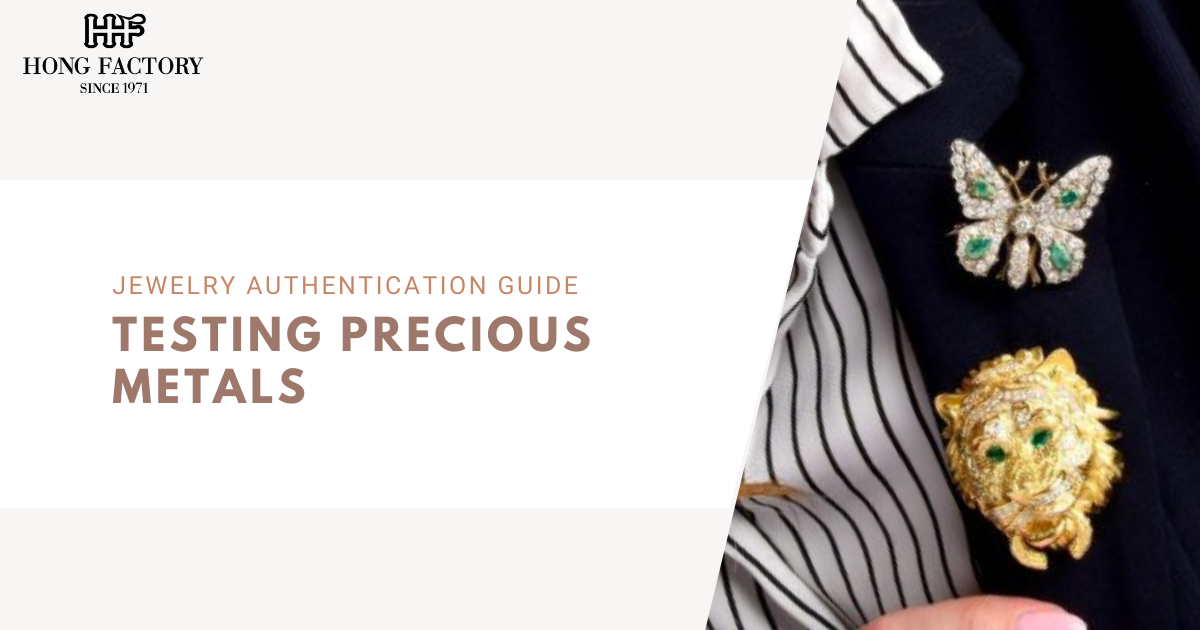Introduction
Determining the authenticity of precious metals is crucial when purchasing jewelry. Gold, silver, platinum, and other valuable metals have distinct properties that help differentiate genuine items from counterfeits. This guide explores reliable methods for testing precious metals and ensuring the quality of your jewelry.
Common Precious Metals and Their Characteristics
- Gold:
- Known for its luster and malleability.
- Measured in karats (e.g., 24K, 18K, 14K), which indicate its purity.
- Non-magnetic and resistant to tarnish.
- Silver:
- Recognizable by its bright, reflective finish.
- Sterling silver contains 92.5% silver, often marked as “925.”
- Prone to tarnishing but can be polished easily.
- Platinum:
- Rare and dense, with a natural white sheen.
- Hypoallergenic and highly durable.
- Typically marked with purity stamps like “PT950.”
- Palladium:
- Lightweight and silvery-white, similar to platinum.
- Corrosion-resistant and hypoallergenic.
- Often stamped with “PD950” or “PD500.”
Reliable Methods for Testing Precious Metals
- Magnet Test: Precious metals are generally non-magnetic. This test can help detect counterfeit items made with magnetic alloys.
Steps:
- Hold a strong magnet near the jewelry.
- If the piece is attracted to the magnet, it likely contains base metals rather than genuine gold, silver, or platinum.
Caution:
- Some non-magnetic metals can still be counterfeit. Use additional tests to confirm authenticity.
- Acid Test: An acid test determines the purity of metals by observing their reaction to specific acids.
Steps:
- Apply a small scratch to an inconspicuous area of the jewelry.
- Use testing solutions designed for gold, silver, or platinum.
- Observe the reaction:
- Genuine gold resists corrosion based on its karat.
- Sterling silver turns a creamy white when exposed to nitric acid.
- Platinum remains unaffected by most acids.
Caution:
- Acid tests can damage the jewelry if performed incorrectly. Seek professional help if unsure.
- Density Test: Each metal has a unique density that can be measured to confirm its authenticity.
Steps:
- Weigh the jewelry using a precise scale.
- Submerge the piece in water and measure its volume displacement.
- Calculate the density (mass/volume) and compare it to standard values:
- Gold: ~19.3 g/cm³
- Silver: ~10.5 g/cm³
- Platinum: ~21.4 g/cm³
- X-Ray Fluorescence (XRF) Test: An advanced, non-invasive method used by professionals to analyze the metal composition.
Benefits:
- Provides precise information about the metal’s content.
- Does not damage the jewelry.
Where to Access:
- Many jewelers and appraisers offer XRF testing services.
- Visual Inspection: A detailed visual inspection can reveal clues about the metal’s authenticity.
What to Look For:
- Hallmarks or purity stamps (e.g., 14K, 925, PT950).
- Signs of discoloration, indicating plating rather than solid metal.
- Scratches or wear that reveal base metal underneath.
Tools for Testing Precious Metals
- Magnet: Used to detect magnetic properties in counterfeit metals.
- Acid Test Kit: Available for purchase online or from jewelry supply stores, with solutions for different metals.
- Scale and Graduated Cylinder: Necessary for performing density tests.
- Jeweler’s Loupe or Magnifying Glass: Helps inspect hallmarks and surface details.
Professional Testing Services
When in doubt, consult a professional jeweler or appraiser for accurate testing. They use advanced tools and have the expertise to identify genuine precious metals without causing damage.
Benefits of Professional Testing:
- Access to XRF machines and other specialized equipment.
- Reliable certification for valuable pieces.
- Expert evaluation of vintage or antique jewelry.
Tips to Avoid Counterfeit Jewelry
- Purchase from reputable jewelers or certified retailers.
- Request documentation, such as a certificate of authenticity.
- Be wary of deals that seem too good to be true.
- Research hallmarks and purity standards for the specific metal you’re buying.
Conclusion
Testing precious metals is a vital step in ensuring the authenticity and value of your jewelry. By combining simple at-home methods with professional evaluations, you can confidently verify the quality of your pieces. Remember, investing time in authentication protects you from counterfeit purchases and ensures your jewelry stands the test of time
